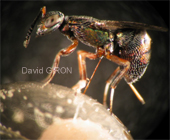

Key references in this research topic:

What did we found so far?

What next?


People involved in this research topic:
Key references in this research topic:

What is the question and the organisms studied?
The way insects acquire, store and use nutrients has tremendous effects on their
life history strategies and population dynamics. Parasitoids are of particular interest
in this context, as many of them do host-
We have a comprehensive budget for this animal, including the quantities of lipids,
sugars and proteins taken through host-
Our group has accumulated a large base of knowledge on a host-

Figure 1. Eupelmus vuiletti female feeding on its host Callosobruchus maculatus.


Current research
This animal produces large eggs and carry few at a time, a strategy prone to egg
limitation in case of the discovery of a jackpot. How do females do to limit the
loss of ovipositional opportunities? It turns out that its reproductive hormonal
response after the discovery of a host (irrespective of its further use!) is the
quickest of any insects, and that the mere discovery of a host induces not only an
increase in ecdysteroids, but even an increase of oogenesis. We are furthermore currently
modelling host-
This parasitoid is not able to produce lipids during its adult life, a most intriguing fact found in other parasitoid species. The work on ecdysteroids needs to be matched by a quantification of Juvenile Hormones and their interplay on the dynamics of the ovarian system. The numerous strategies developed by this species to face the stochasticity of encounters with hosts call for a more precise experimental definition of the latter. We intend to pursue this type of work at the interface between integrative physiology, behavioural ecology and population ecology.
Jean-
David Giron
Bertanne Visser
Fabrice Vannier
Richard, R., Casas, J. (2012), A quantitative framework for ovarian dynamics. Functional
Ecology, 26: 1399–1408. doi: 10.1111/j.1365-
Casas, J., & McCauley, E. (2012). Daily foraging cycles create overlapping time-
Casas J., Vannier F., Mandon N., Delbecque JP., Giron D. & Monge JP. (2009). Mitigation
of egg limitation in parasitoids: immediate hormonal response and enhanced oogenesis
after host use. Ecology, 90, 537-
Richard, R. & J. Casas (2009), Stochasticity and controllability of nutrient sources
in foraging: host-
Casas, J., S. Pincebourde, N. Mandon, F. Vannier, R. Poujol & D. Giron (2005) Lifetime nutrient dynamics reveal simultaneous capital and income breeding in a parasitoid.
Ecology, 86: 545-

Institut de Recherche sur la Biologie de l'Insecte
UMR 7261 Faculté des Sciences et Techniques
Avenue Monge, Parc Grandmont
37200 TOURS (France)


